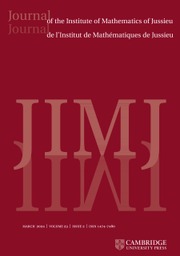No CrossRef data available.
Article contents
A  $C^r$-CONNECTING LEMMA FOR LORENZ ATTRACTORS AND ITS APPLICATION ON THE SPACE OF ERGODIC MEASURES
$C^r$-CONNECTING LEMMA FOR LORENZ ATTRACTORS AND ITS APPLICATION ON THE SPACE OF ERGODIC MEASURES
Published online by Cambridge University Press: 26 August 2025
Abstract
For every  , we prove a
, we prove a  $C^r$-connecting lemma for Lorenz attractors. To be precise, for a Lorenz attractor of a
$C^r$-connecting lemma for Lorenz attractors. To be precise, for a Lorenz attractor of a  $3$-dimensional
$3$-dimensional  $C^r$ (
$C^r$ ( $r\geq 2$) vector field, a heteroclinic orbit associated to the singularity and a critical element can be created through arbitrarily small
$r\geq 2$) vector field, a heteroclinic orbit associated to the singularity and a critical element can be created through arbitrarily small  $C^r$-perturbations. As an application, we show that for
$C^r$-perturbations. As an application, we show that for  $C^r$-dense geometric Lorenz attractors, the Dirac measure of the singularity is isolated inside the space of ergodic measures, and thus, the ergodic measure space is not connected, while for
$C^r$-dense geometric Lorenz attractors, the Dirac measure of the singularity is isolated inside the space of ergodic measures, and thus, the ergodic measure space is not connected, while for  $C^r$-generic geometric Lorenz attractors, the space of ergodic measures is path connected with dense periodic measures. In particular, the generic part proves a conjecture proposed by C. Bonatti [11, Conjecture 2] in
$C^r$-generic geometric Lorenz attractors, the space of ergodic measures is path connected with dense periodic measures. In particular, the generic part proves a conjecture proposed by C. Bonatti [11, Conjecture 2] in  $C^r$-topology for Lorenz attractors.
$C^r$-topology for Lorenz attractors.
Information
- Type
- Research Article
- Information
- Copyright
- © The Author(s), 2025. Published by Cambridge University Press
Footnotes
Y. Shi was partially supported by National Key R&D Program of China (2021YFA1001900) and NSFC (12090015).
X. Tian was partially supported by NSFC (12471182, 12071082).
X. Wang was the corresponding author and was partially supported by National Key R&D Program of China (2021YFA1001900), NSFC (12071285) and Innovation Program of Shanghai Municipal Education Commission (No. 2021-01-07-00-02-E00087)


